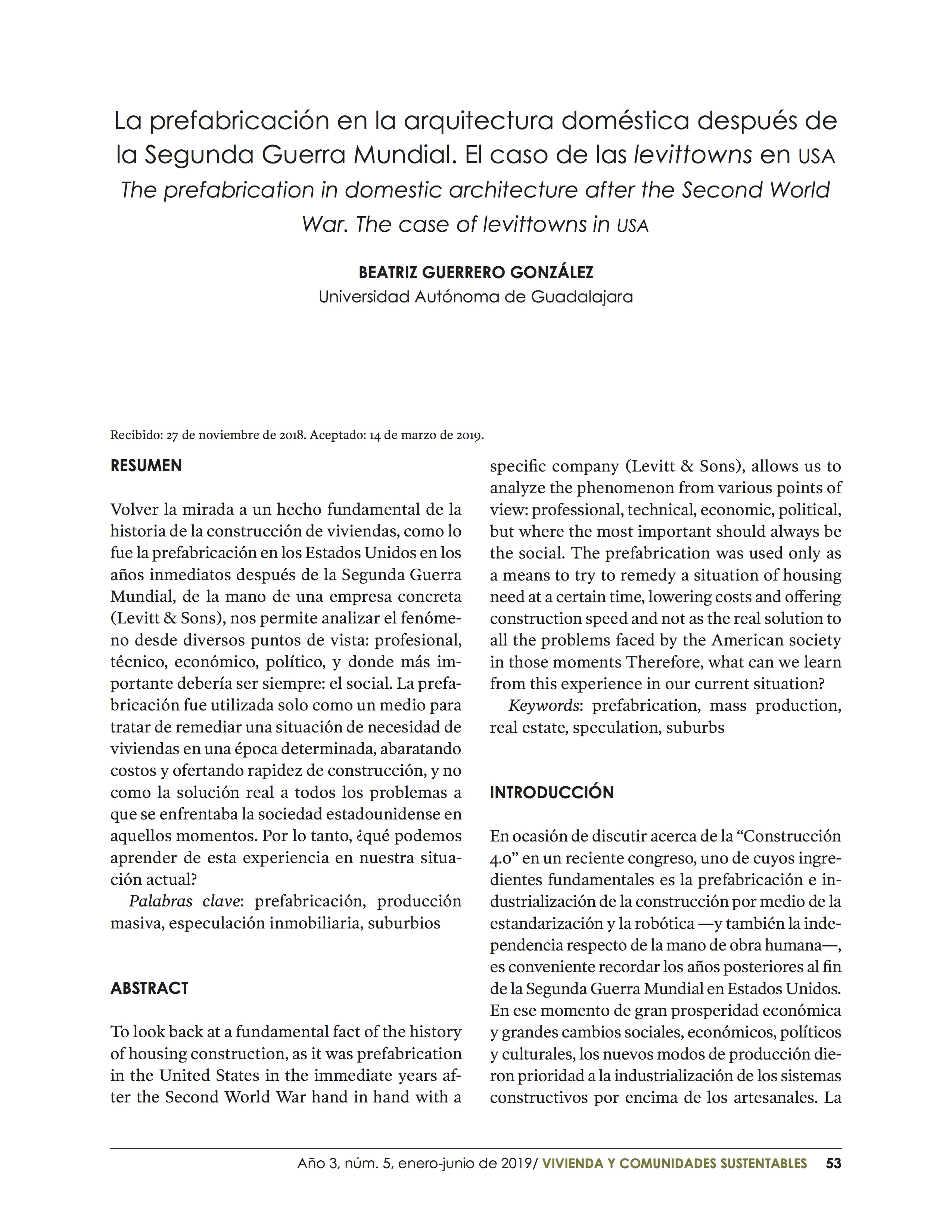The prefabrication in domestic architecture after the Second World War. The case of levittowns in USA
DOI:
https://doi.org/10.32870/rvcs.v0i5.107Keywords:
prefabrication, mass production, real estate, speculation , subursAbstract
To look back at a fundamental fact of the history of housing construction, as it was prefabrication in the United States in the immediate years after the Second World War hand in hand with specific company (Levitt & Sons), allows us to analyze the phenomenon from various points of view: professional, technical, economic, political, but where the most important should always be the social. The prefabrication was used only as a means to try to remedy a situation of housing need at a certain time, lowering costs and offering construction speed and not as the real solution to all the problems faced by the American society in those moments Therefore, what can we learn from this experience in our current situation?Metrics
References
Architectural Forum (1949), "4,000 Houses per Year", abril, Architectural Forum, pp. 86-93.
Baxandall, R. y E. Ewen (2000), Picture Windows. How the Suburbs Happened, Nueva York, Basic Books.
Eames, Charles; Matter, Herbert y R. Buckminster Fuller (1944), "Prefabrication", Arts & Architecture, julio 61:7, pp. 29-35.
Gans, Herbert J. (1982), The Levittowners. Ways of Life and Politics in a New Suburban Community, Nueva York, Columbia University Press.
Goldstein, Barbara (ed.) (1998), Arts & Architecture. The Entenza Years, Santa Mónica, Hennessey + Ingalls.
Hayden, Dolores (2003), Building Suburbia. Green Fields and Urban Growth. 1920-2000, Nueva York, Vintage Books.
Kelly, Barbara M. (1993), Expanding the American Dream. Building and Rebuilding Levitown, Albany (NY), State University of New York.
Kelly, Burnham (1951), The Prefabrication of Houses, Nueva York y Londres, The MIT; John Wiley & Sons y Chapman y Hall. Disponible en: https://babel.hathitrust.org/cgi/pt?id=mdp.390 15026795446;view=2up;seq=10. Consultado: 29 de enero de 2019.
LANDIA (1951), Architectural Forum, febrero.
Liell, John (1984), Levittown: A Study in Community Planning and Development, Ann Arbor, Yale University.
Mohan, Geoffrey (1997), Suburban Pioneer, New Day, 28, septiembre.
Morrow Ford, Katherine y Thomas H. Creighton (1951), The American House Today, Nueva York, Reinhold.
Redfeld, Charles E. et al., (1951), "The Impact of Levittown on Local Government", Journal of the American Institute of Planners, 17:3, pp. 130-141. United States Congress (1949), Housing Act of 1949. Disponible en: https://www.loc.gov/law/help/statutes-at-large/81st-con- gress/session-1/c81s1ch338.pdf. Consultado: 27 de enero de 2019.
https://doi.org/10.1080/01944365108979326
Wright, Gwendolyn (1983), Building the Dream. A social History of Housing in America, Cambridge (MA), Londres, The MIT Press.
--- (2008), USA. Modern Architectures in History, Londres, Reaktion Books.

Downloads
Published
How to Cite
Issue
Section
License
Copyright (c) 2019 Vivienda y Comunidades Sustentables

This work is licensed under a Creative Commons Attribution-NonCommercial-NoDerivatives 4.0 International License.
The authors who publish in this journal accept the following conditions:
In accordance with the copyright legislation, Sustainable Housing and Communities recognizes and respects the moral right of the authors, as well as the ownership of the patrimonial right, which will be transferred to the University of Guadalajara for its dissemination in open access. Sustainable Housing and Communities does not charge authors for submitting and processing articles for publication. Authors may make other independent and additional contractual agreements for the non-exclusive distribution of the version of the article published in Sustainable Housing and Communities (for example, include it in an institutional repository or publish it in a book) as long as they clearly indicate that the work is published for the first time in Sustainable Housing and Communities.





